What is the IRC 415(b) Limit?
The IRC 415(b) limit is a provision in the Internal Revenue Code that sets a maximum limit on the annual benefits a participant in a qualified retirement plan can receive. This limit is crucial for maintaining the tax-advantaged status of retirement plans and ensuring fair and equitable benefits for all participants. Employers, plan administrators, and participants must understand this limit to ensure compliance and make informed retirement planning decisions.
How Does the irc 415(b) Limit Work?
The irc 415(b) limit calculates the maximum annual benefit a participant can receive from a defined benefit plan. It takes into account various factors such as the participant’s age, years of service, and compensation history. The IRS adjusts this limit annually to account for inflation and changes in the cost of living.
To determine the annual benefit, the plan administrator typically uses a formula based on the participant’s highest average compensation over a specified period and their years of service. The resulting amount should not exceed the irc 415(b) limit set by the IRS for that year.
Implications for Defined Benefit Plans
Defined benefit plans promise a specific benefit amount upon retirement, often based on a formula involving salary and years of service. The IRC 415(b) limit ensures that these plans do not provide excessively high benefits that could result in tax penalties or disqualification of the plan’s tax-advantaged status.
Employers sponsoring defined benefit plans must monitor and adjust plan benefits to comply with the irc 415(b) limit. Failure to do so could lead to IRS penalties and complications for plan participants.
Considerations for Plan Sponsors
For employers and plan sponsors, staying compliant with the IRC 415(b) limit requires diligent monitoring and annual calculations. Employers should work closely with plan administrators and financial advisors to ensure that plan benefits align with the IRS regulations.
Periodic reviews of plan documents, participant data, and benefit calculations can help identify any potential issues or discrepancies. Employers may also consider implementing software or tools that automate the IRC 415(b) limit calculations, reducing the risk of errors and ensuring timely compliance.
Planning for Retirement
Understanding the IRC 415(b) limit is also crucial for participants planning their retirement. Knowing the maximum annual benefit can help participants make informed decisions about their retirement savings, investment strategies, and other financial planning activities.
Participants nearing retirement age should review their defined benefit plan statements and consult with financial advisors to understand how the IRC 415(b) limit may impact their retirement income. Adjustments to retirement contributions, investment allocations, and other financial plans may be necessary to ensure a comfortable retirement within the IRC 415(b) limit constraints.
Strategies to Manage IRC 415(b) Limit Compliance
Managing compliance with the IRC 415(b) limit requires proactive strategies and ongoing attention to detail. Here are some strategies that employers and plan sponsors can implement:
Regular Plan Audits:
Conduct regular audits of the defined benefit plan to ensure compliance with the IRC 415(b) limit. This includes reviewing plan documents, participant data, and benefit calculations to identify any discrepancies or issues.
Employee Education:
Educate employees about the IRC 415(b) limit and its implications for retirement planning. Providing employees with clear and concise information can help them make informed decisions and avoid potential pitfalls.
Consultation with Experts:
Seek advice from financial advisors, tax professionals, and legal experts who specialize in retirement plan compliance. Their expertise can provide valuable insights and guidance on managing the IRC 415(b) limit effectively.
Utilize Technology:
Invest in software or tools that automate the IRC 415(b) limit calculations and compliance monitoring. This can help reduce the administrative burden and minimize the risk of errors or oversights.
Want to Know More about 415(b) Plans?
Click here to Schedule a Free Consultation Today!Conclusion
The IRC 415(b) limit plays a vital role in regulating defined benefit plans and ensuring compliance with IRS regulations. Employers, plan administrators, and participants must understand this limit and its implications to avoid potential penalties and complications.
Staying informed, conducting regular reviews, and seeking professional guidance can help navigate the complexities of the IRC 415(b) limit and ensure successful retirement planning for all parties involved.
By implementing proactive strategies, leveraging technology, and fostering employee education, employers and plan sponsors can effectively manage IRC 415(b) limit compliance and support their employees’ retirement goals.


